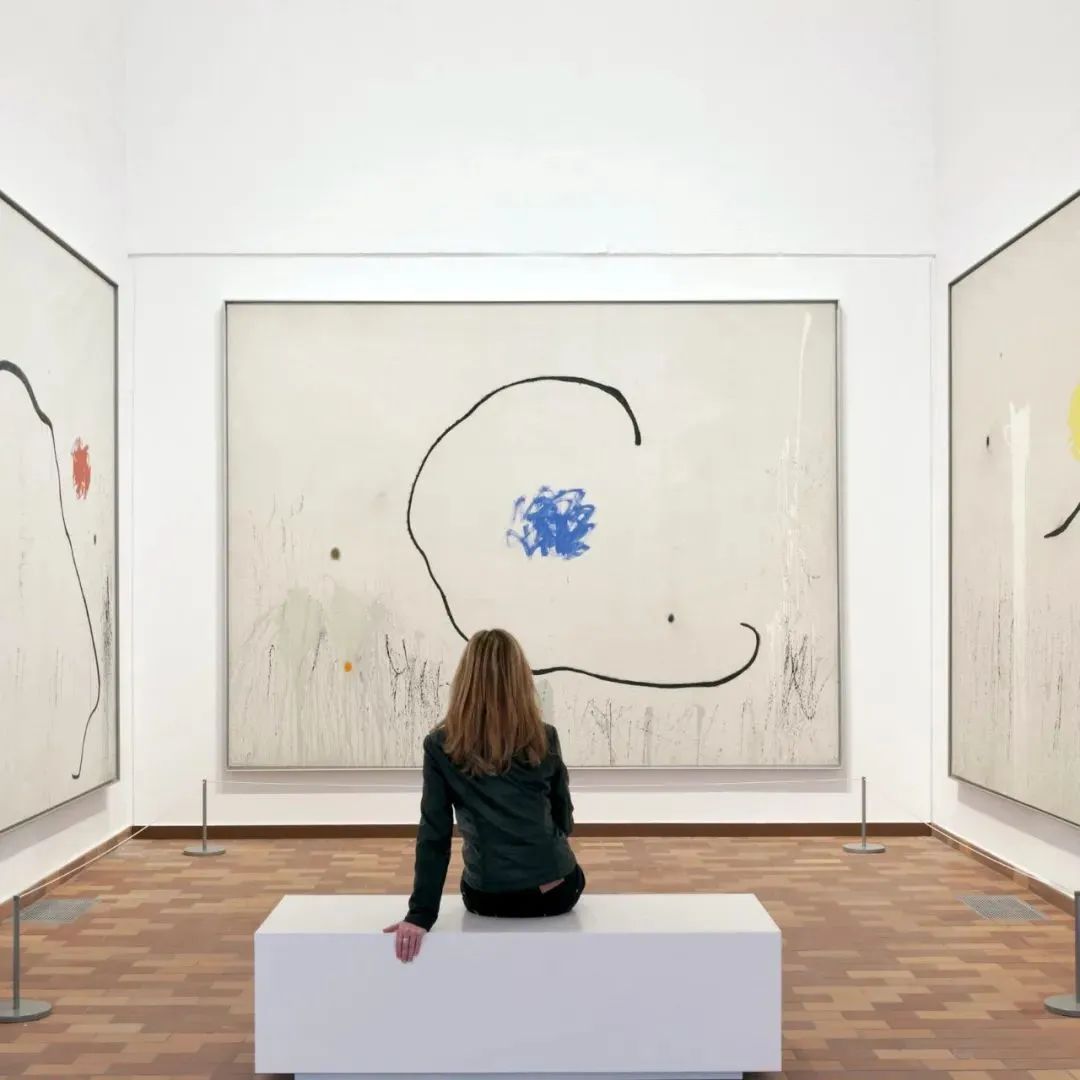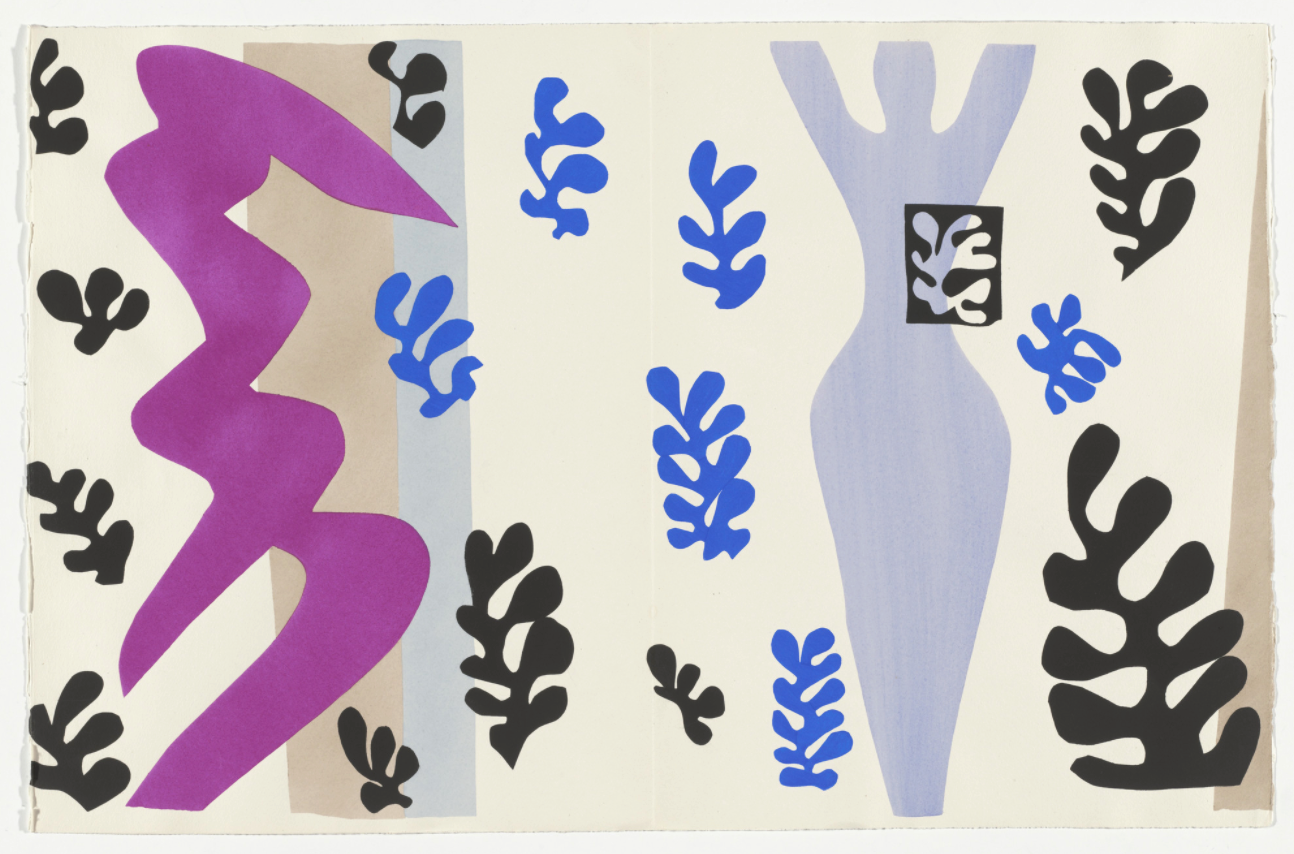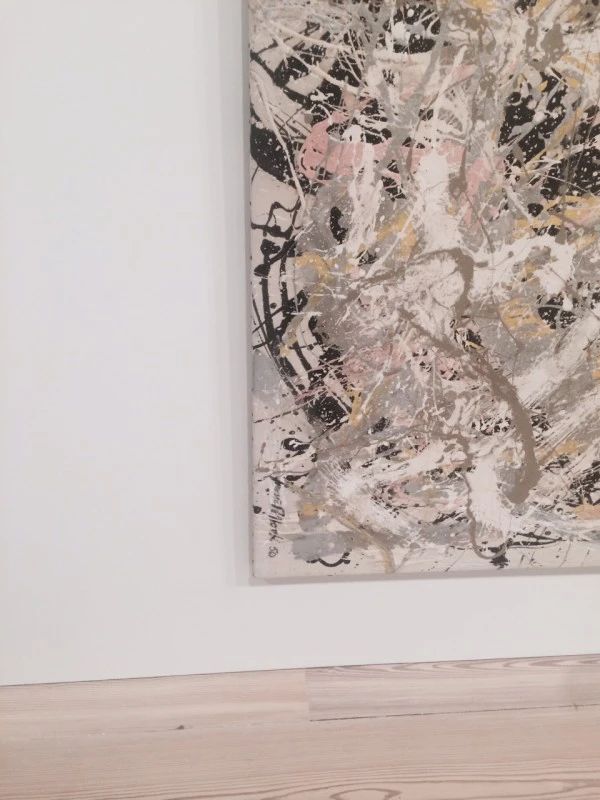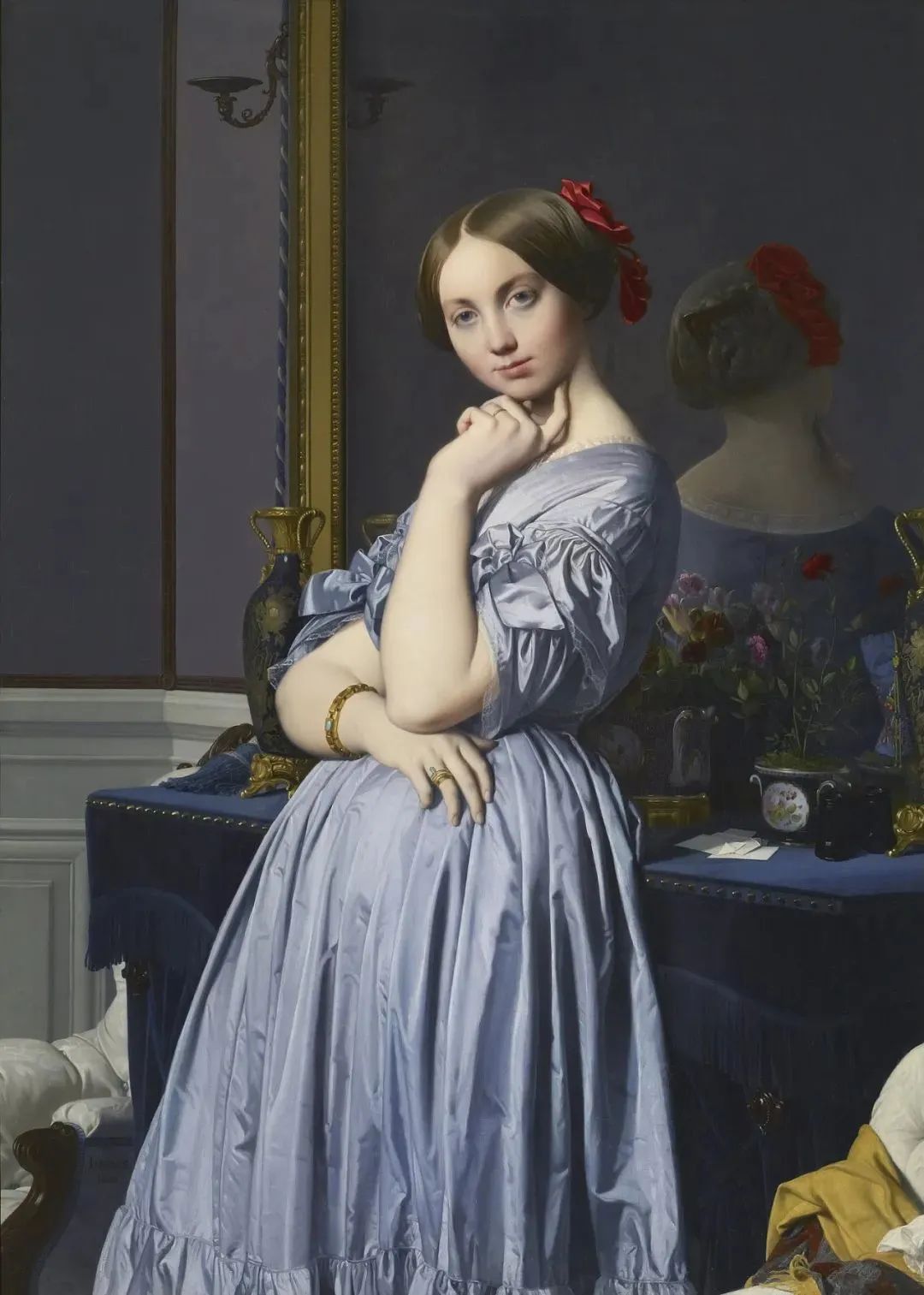* Hanging works of the Juan Miro Foundation *
The so-called “360 lines, every line has a way”, and “hanging pictures” is no exception. In today’s era of “White Cube”, the standard for hanging paintings seems to have been institutionalized. The works with four white walls, open spacing, standard color temperature and illumination are particularly independent and perceptual. However, this is only the result of hundreds of years of history……
#01
# Who decides to watch the way👀
In October 1961, the exhibition “Matisse’s Last Work: Large Cut Gouaches” (The Last Works of Matisse: Large Cut) opened at the Museum of Modern Art in new york. The exhibition selected 40 gouache paintings cut and collaged before the artist’s death. In his later years, Matisse’s painting tools changed from brushes to scissors, and his bold and colorful works show his undiminished creativity.

* Henri Matisse, Le Bateau, paper-cut, 13.84 × 10.33cm,1953 *
However, a fatal mistake occurred in the exhibition arrangement: a keen observer discovered after three visits that the “Le Bateau” in the exhibition was hanging in the wrong direction, and the original positive clip art was “upside down” by the curator …… After the incident was exposed, the director of the exhibition finally took the painting “face to the sky” and explained to the media: “This is just carelessness”.
This is indeed just a “careless” mistake, but it is also enough to show that how to view the painting is not actually “decided” by the viewer-the molding exhibition that people see has long been the curator, the museum site, and even the environment. “Sound, light, and electricity” are heavily filtered. In other words, what we see and feel is what the exhibitor intends to see.

* Figure 1: Henry Matisse, The Knife Thrower, 42.2 × 64.9cm,1943-1947
Figure 2: Henry Matisse, Forms, 42 × 65.5cm,1943-1947 *
Fifty years after the “Matisse upside down” incident, a similar incident occurred at the Whitney Museum of American Art. In 2015, “Number 27” by abstract expressionist master Pollock was hung vertically in the exhibition. This work is shown horizontally in the exhibition brochure, as well as in Pollock’s catalogue.
However, a museum spokesman claimed that the “non-traditional suspension” was intentional and based on a “vertical” display in Pollock’s 1950 Betty Parsons exhibition in New York. “And, hanging vertically,” explains the curator, “will have a greater sense of scale on small exhibitions.”

* Figure 1: Jackson Pollock, Number 27, oil on canvas, enamel, aluminum paint, 124.6 × 269.4cm,1950
Figure 2: Installation of Number 27 at the Whitney Museum of American Art, 1950 *
Whether hanging horizontally or vertically in the future, Number 27 has been written into history in an alternative way. The initiative of the way the painting is hung is almost always in the hands of the exhibition party, which dominates the viewer’s understanding of the artwork.
As research has shown, when people walk into a gallery, they generally look for two large works of similar size, and their styles and colors often complement each other. After that, the viewer will notice “brothers and sisters” who have the same feeling “. The curators spread the pieces evenly to create a sense of rhythm and harmony. Therefore, it is never you who decides the way of seeing. “How to hang” is not only a second interpretation of the painting, but also a “power struggle”……
#02
# Salon, defeated salon and white cube◻️

* David Teniers the Younger “Gallery of Archduke Leopold Wilhelm in Brussels (Vienna)”, oil on canvas, 123 × 163cm,1651 *
“Salon”-style exhibitions once represented the way galleries hung their works. In today’s most “White Cube” exhibition halls, “Salon” is already a minority, and we may still see it in the artist’s works.
For example, the classic “The Paintings of Gelsant” by the Rococo period artist Jean Anthony Wardo (Jean-Antoine Watteau) painted the “salon” of that time: the gallery was full of works of art from floor to ceiling, arranged in layers according to genres, and there was no gap between them. Among the dozens of suffocating dense paintings, you can vaguely see the walls are crimson, and the buyers and sellers in front of the counter are talking happily. This environment symbolizes the life and interest of the upper class.

* Figure 1: Jean-Anthony Wardo, The Signboard of Gersaint, 182 × 306cm, Oil on canvas, 1720
Figure 2: Official Salon Exhibition of France, 1767 *
It was a few years after the artist completed this painting that the Carré Salon, located in the Louvre, was officially upgraded to an annual cultural event of the bourgeoisie. Participants exchange knowledge in the salon, and art goes from the court to the elite. However, when viewing a large number of unrelated works at the same time, the viewer will see the gallery as a whole painting world, rather than a space for interpreting the artist’s work. Obviously, the salon at this time is only for purchasing services, and hanging paintings is like goods on shelves: only for the dazzling array, not for the blending of scenes.
This situation was rewritten after the “losing election salon” incident. The bourgeoisie replaced the declining aristocracy, and the art market became the “sponsor” of artists “. After the thousands of paintings selected for the annual salon exhibition are reviewed, only more than 2,000 can be exhibited. The rest were stamped with the “R” (refuse) mark, symbolizing that they were despised by art dealers and could no longer be traded. At this time, the theme of art was officially “limited” to the arty and sentimental, or pornographic neoclassical works painted by Angle. Artists need to cater to this taste or face losing the election.
The “Lose Salon” exhibition, led by artists such as Courbet and Delacroix, paved the way for avant-garde and daring ways to hang their works. The exhibition brought together a large number of works that were not accepted by the salon system, and artists began to decide how to hang their paintings on their own. At this time, hanging paintings have become a part of art. Artworks are no longer just “commodities”. Different arrangements of paintings can carry out “dialogue”, and the exhibition is thus presented as a coherent whole with a theme.

* Figure 1: Ingres “Portrait of Comtesse d’Haussonville”, oil on canvas, 131.8 × 92cm,1845
Figure 2: Manet’s Lunch on the Grass, oil on canvas, 208 × 265.5cm,1863
Figure 3: Gustave Courbet (Gustave Courbet) “The Painter’s Studio” (Oil on canvas, 361 × 598cm,1855)
Figure 4: Eugès Delacroix, Bride of abydos, 1857 *
The “White Cube” we see today is inseparable from the help of the “losing salon”, and the idea that art is independent of its background is rising. This time, the walls and ceiling of the exhibition hall are painted white, the decorative lamps are simplified, and the paintings are far apart and written independently. Viewers no longer need to crouch down or climb ladders to admire the paintings. Alfred Barr, MoMA’s first curator, said: “I hope the visual impact of each painting or sculpture can speak for itself. Neutral walls, controlled lighting and lack of decoration help isolate and enhance the artwork.”
From this, the monochrome wall of the exhibition has been the basic operation. When people visit, they can experience the independent sensibility of each work in detail, which weakens the historical narrative behind it to the greatest extent. As the psychologist Daniel Berlyne put it: “A work of art is self-contained and isolated from its background. The influence of a painting has nothing to do with the wall on which it is hung.” This concept has dominated the discourse of art throughout the 20th century.

* Figure 1:MoMA exhibition “Cubism and Abstraction”, 1936
Figure 2:Tate’s “Walk through British Art” exhibition, 2022
Figure 3: Viewers in front of the painting “Night Watch” in the collection of the National Museum of the Netherlands *
#03
# Can I “hang pictures” at will?🙋♂️
Since then, how to hang paintings has even developed a set of “rules”. Christie’s art processor once gave an answer: “Modern and contemporary works are usually hung 1.55 meters from the ground in the center of the picture, and the works of the ‘old master’ will be hung higher.” Generally speaking, the viewer and the painting need to master the “single row line of sight flush rule”, while the spacing between the works is controlled at 50-100cm according to the size, which is better than dense.

* Figure 1: Art display inside Buckingham Palace
Figure 2: Home of designer Yves Saint Laurent *
But this is only an official “operation”. As far as collectors are concerned, how to hang paintings is naturally their right, and the combination of different schools and art media can often collide with different sparks.
However, while the improvement of the artist’s self-nature shines the spotlight on the creator, many artists also gave specific instructions for hanging his work. For example, Le Corbusier insisted on placing his works 1.83 meters from the ground, while Mark Rothko asked his groups of paintings to be hung in dim light, kept very close to the viewer, and could not be interspersed with other works of art.

* Le Corbusier, Bull III, 1953 *
This was the case with the artist’s designs for the Roscoe Church during his lifetime. In this church, several giant dark blue monochrome paintings hang around-Rothko wants to make the viewer feel immersed in it, and the quiet and pure spiritual power it conveys is also revealed.
Here, a piece of work achieves “blending of scenes” by hanging, and respecting the artist’s thinking becomes the criterion. The combination of painting and environment also allows people to glimpse one of the artist’s personalities. In the case of Rothko, for example, if you mix it with brightly colored works, you will not be able to achieve the above effect. Therefore, when installing works, following the artist’s “hanging painting instructions” can sometimes increase the efficiency of the expression of works of art.

* Figure 1: Rothko Chapel
Figure 2: Mark Rothko, Untitled, paper synthetic polymer coatings and inks, 102.2 × 67.4cm,1969 *
In fact, when we talk about how to “hang a picture”, we are also talking about a part of art history, which has not been opened for a long time. High or low, sparse or dense, hanging paintings actually reflect the change of the social role of art: from ornaments to works of art, and then to the works of artists. In this process, the power of the “handover stick” from the artist to the curator and artist. Sometimes, as a collector, you seem to have no intention of “hanging paintings”, but you can’t escape the “cage” of history “.
(Source: Harper’s Bazaar Art)













